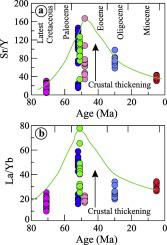Our official English website, www.x-mol.net, welcomes your feedback! (Note: you will need to create a separate account there.)
Melting of the juvenile lower crust in a far-field response to roll-back of the southern Neotethyan oceanic lithosphere: The Oligocene adakitic dacites, NE Turkey
Lithos ( IF 3.5 ) Pub Date : 2020-10-01 , DOI: 10.1016/j.lithos.2020.105614 Orhan Karsli , Şemsettin Caran , Hakan Çoban , Fırat Şengün , Osman Tekkanat , Tom Andersen
Lithos ( IF 3.5 ) Pub Date : 2020-10-01 , DOI: 10.1016/j.lithos.2020.105614 Orhan Karsli , Şemsettin Caran , Hakan Çoban , Fırat Şengün , Osman Tekkanat , Tom Andersen

|
Abstract Late Cenozoic tectono-thermal events and associated magmatism in the Sakarya Zone (SZ) are still contested. Although documented in the western part of the SZ, thus far, no magmatic activity has been identified in the eastern part of the Oligocene SZ. Here, we report a newly identified Oligocene magmatism to interpret the genesis with tectonic setting and gain new insight into the geological evolution of the eastern SZ. We present extensive geochemical, bulk-rock Sr Nd and zircon Hf isotope, and zircon U Pb chronological analyses for the Tepebasi dacites in the Artvin region, NE Turkey. Zircon U Pb dating analyses revealed a dacite formation age of ∼29.8 ± 0.3 Ma. Geochemically, with a K2O/Na2O ratio of 0.5 to 0.6, they are composed of rocks of a medium-K calc-alkaline adakitic affinity. The samples are further characterized by low Y (6–7 ppm), and high Sr (362–588 ppm) and Sr/Y ratios (58–98), with low Mg# (41–45) values, demonstrating a close affinity with the crustal source of adakitic rocks. They have slightly radiogenic isotope concentrations (87Sr/86Sr(t) = 0.70460–0.70544, eNd(t) = +1.7 to +2.0), and single-stage Nd model ages of TDM1 = 0.61–0.63 Ga, as well as uniform and positive eHf (t) of 8.2–10.5, with young Hf depleted mantle ages (TDM1 = 0.31–0.41 Ga). These isotopic features, in combination with the geochemical signature, preclude a mantle origin. Instead, they most likely originated from a juvenile mafic lower crustal material by low degree partial melting (
中文翻译:

对新特提斯大洋岩石圈南部回滚的远场响应中幼年下地壳的融化:渐新世埃达克英安岩,土耳其东北部
摘要 萨卡里亚带(SZ)的晚新生代构造热事件和相关岩浆作用仍存在争议。尽管在 SZ 西部有记载,但迄今为止,在渐新世 SZ 东部尚未发现岩浆活动。在这里,我们报告了一个新发现的渐新世岩浆作用,以解释构造环境的成因,并对深圳东部的地质演化有新的认识。我们对土耳其东北部 Artvin 地区的 Tepebasi 英安岩进行了广泛的地球化学、大块岩石 Sr Nd 和锆石 Hf 同位素以及锆石 U Pb 年代学分析。锆石 U Pb 测年分析显示英安岩的形成年龄约为 29.8 ± 0.3 Ma。在地球化学上,K2O/Na2O 的比率为 0.5 到 0.6,它们由具有中等钾钙碱性埃达克亲合力的岩石组成。样品的进一步特征是低 Y (6–7 ppm)、高 Sr (362–588 ppm) 和 Sr/Y 比率 (58–98),以及低 Mg# (41–45) 值,表明亲和性很接近与埃达克岩的地壳来源。它们具有轻微的放射性同位素浓度(87Sr/86Sr(t) = 0.70460–0.70544,eNd(t) = +1.7 到 +2.0)和 TDM1 = 0.61–0.63 Ga 的单级 Nd 模型年龄,以及均匀和正 eHf (t) 为 8.2-10.5,年轻的 Hf 耗尽地幔年龄(TDM1 = 0.31-0.41 Ga)。这些同位素特征与地球化学特征相结合,排除了地幔起源。相反,它们很可能起源于低度部分熔融的幼年基性下地壳物质。它们具有轻微的放射性同位素浓度(87Sr/86Sr(t) = 0.70460–0.70544,eNd(t) = +1.7 到 +2.0)和 TDM1 = 0.61–0.63 Ga 的单级 Nd 模型年龄,以及均匀和正 eHf (t) 为 8.2-10.5,年轻的 Hf 耗尽地幔年龄(TDM1 = 0.31-0.41 Ga)。这些同位素特征与地球化学特征相结合,排除了地幔起源。相反,它们很可能起源于低度部分熔融的幼年基性下地壳物质。它们具有轻微的放射性同位素浓度(87Sr/86Sr(t) = 0.70460–0.70544,eNd(t) = +1.7 到 +2.0)和 TDM1 = 0.61–0.63 Ga 的单级 Nd 模型年龄,以及均匀和正 eHf (t) 为 8.2-10.5,年轻的 Hf 耗尽地幔年龄(TDM1 = 0.31-0.41 Ga)。这些同位素特征与地球化学特征相结合,排除了地幔起源。相反,它们很可能起源于低度部分熔融的幼年基性下地壳物质。
更新日期:2020-10-01
中文翻译:

对新特提斯大洋岩石圈南部回滚的远场响应中幼年下地壳的融化:渐新世埃达克英安岩,土耳其东北部
摘要 萨卡里亚带(SZ)的晚新生代构造热事件和相关岩浆作用仍存在争议。尽管在 SZ 西部有记载,但迄今为止,在渐新世 SZ 东部尚未发现岩浆活动。在这里,我们报告了一个新发现的渐新世岩浆作用,以解释构造环境的成因,并对深圳东部的地质演化有新的认识。我们对土耳其东北部 Artvin 地区的 Tepebasi 英安岩进行了广泛的地球化学、大块岩石 Sr Nd 和锆石 Hf 同位素以及锆石 U Pb 年代学分析。锆石 U Pb 测年分析显示英安岩的形成年龄约为 29.8 ± 0.3 Ma。在地球化学上,K2O/Na2O 的比率为 0.5 到 0.6,它们由具有中等钾钙碱性埃达克亲合力的岩石组成。样品的进一步特征是低 Y (6–7 ppm)、高 Sr (362–588 ppm) 和 Sr/Y 比率 (58–98),以及低 Mg# (41–45) 值,表明亲和性很接近与埃达克岩的地壳来源。它们具有轻微的放射性同位素浓度(87Sr/86Sr(t) = 0.70460–0.70544,eNd(t) = +1.7 到 +2.0)和 TDM1 = 0.61–0.63 Ga 的单级 Nd 模型年龄,以及均匀和正 eHf (t) 为 8.2-10.5,年轻的 Hf 耗尽地幔年龄(TDM1 = 0.31-0.41 Ga)。这些同位素特征与地球化学特征相结合,排除了地幔起源。相反,它们很可能起源于低度部分熔融的幼年基性下地壳物质。它们具有轻微的放射性同位素浓度(87Sr/86Sr(t) = 0.70460–0.70544,eNd(t) = +1.7 到 +2.0)和 TDM1 = 0.61–0.63 Ga 的单级 Nd 模型年龄,以及均匀和正 eHf (t) 为 8.2-10.5,年轻的 Hf 耗尽地幔年龄(TDM1 = 0.31-0.41 Ga)。这些同位素特征与地球化学特征相结合,排除了地幔起源。相反,它们很可能起源于低度部分熔融的幼年基性下地壳物质。它们具有轻微的放射性同位素浓度(87Sr/86Sr(t) = 0.70460–0.70544,eNd(t) = +1.7 到 +2.0)和 TDM1 = 0.61–0.63 Ga 的单级 Nd 模型年龄,以及均匀和正 eHf (t) 为 8.2-10.5,年轻的 Hf 耗尽地幔年龄(TDM1 = 0.31-0.41 Ga)。这些同位素特征与地球化学特征相结合,排除了地幔起源。相反,它们很可能起源于低度部分熔融的幼年基性下地壳物质。



























 京公网安备 11010802027423号
京公网安备 11010802027423号